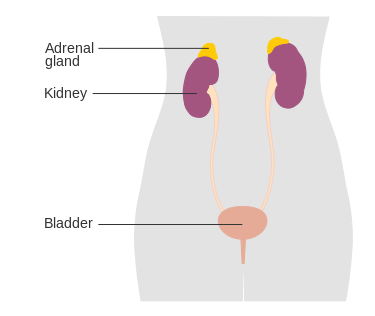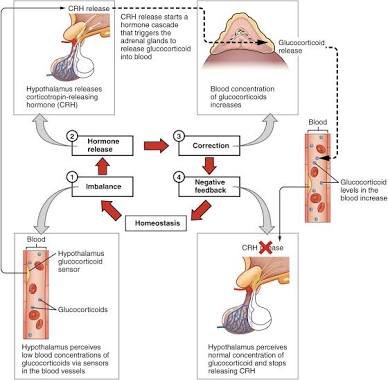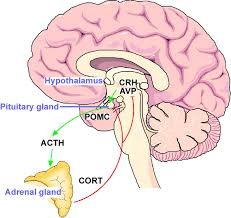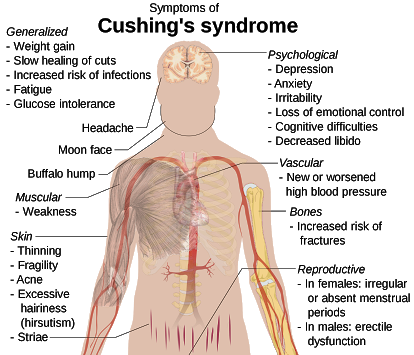Today,I'll be writing on a very interesting and probably not too popular topic.
Adrenaline. You can read the post here.
I felt it wouldn’t be out of place to shed more light on this and other hormones produced by this gland.
This post was inspired by a very wonderful and educating write up from a fellow steemian(@suesa),on
Breaking down its nomenclature, adrenal gland was derived as follows;
“Ad” (near) “renal” (kidneys).
The human body has got two adrenal glands which are hormone producing structures that sits on top of both kidneys located in the lower back area of our body (retroperitoneal).

“Diagram showing the position of the adrenal glands CRUK 343” by Cancer Research UK is licensed under CC BY 4.
They are also referred to as a suprarenal gland.
“Supra”-(on top) and “Renal” (kidney).
Description.
The adrenal glands are triangular shaped(right adrenal gland) and half moon shaped (left adrenal gland). They both have a yellowish color measuring about 1.5 inches in height and 3 inches in length sitting on each kidneys. Each of these glands weigh about 4-5 grams.
Structure.
A very easy way to understand the structure of the adrenal gland is by likening it to that of an avocado fruit.
Made up of three distinct layers;
The capsule.
The Cortex.
The Medulla.

“Illustration from Anatomy & Physiology, by OpenStax College Connexions Website.” by Anatomy and Physiology is licensed under CC BY 3.
The capsule.
Envision the skin of the avocado as the capsule of the adrenal gland. It really doesn’t play a part function-wise on the gland it self. it is a made up of a protective layer of fat surrounding the gland.
The Cortex.
This can be likened to the flesh of the avocado. It makes up about 80 percent of Total gland’s volume.
The Cortex is divided into three layers or zones. Starting from the outermost to the inner most, they are:
- Zona Glomerulosa.
- Zona Fasciculata.
- Zona Reticularis.
Each of these layers makes up the Cortex and they have different functions altogether.
The Medulla
The medulla sits in the middle as the inner most part of the gland contributing about 20percent of its total volume.
There are some known variables of an adrenal gland.
It may not develop at all, may develop with a partial or complete lack of cortex, Or may develop in an unusual Position.
Supplies to the adrenal Gland.
Three arteries usually supply the adrenal gland.
They are the Superior, Middle and Inferior Suprarenal arteries.
Two veins drain the adrenal glands. One for each gland. They are the right and left Suprarenal veins.
What are the Hormones Produced by the Adrenal Gland.
I will like to speak on this looking specifically at the different zones of this gland.
From the adrenal Cortex.
- Zona fasciculata -Glucocorticoids (examples are cortisone, cortisol)
- Zona glomerulosa -Mineralocorticoids (example- aldosterone)
- Zona reticularis- Androgens (example is dehydro-epiandrosterone).
From the adrenal medulla.
- Adrenaline or epinephrine.
- Nor adrenaline or Nor epinephrine.
Functions of these Hormones.
Glucocorticoids (e.g cortisone, cortisol e.t.c),
Helps in the normal response to stress in conjunction with adrenaline and noR-adrenaline, it is useful in the utilization of Carbohydrates,Proteins and Fats and for suppressing inflammation.Mineralocorticoids e.g Aldosterone,
Helps in the regulation of salt and water balance in the body, Indirectly useful in the Regulation of Blood pressures.Androgens e.g dehydro-epiandrosterone are a major contributor to human sex hormones in both male and female.
Adrenaline or epinephrine.
Sure every body knows that adrenaline prepares-the body for response of fight, flight, fright. Other very important functions are linked with the
Increase in the rate of contraction of the heart, rate and depth of breathing and general body metabolism.
Adrenaline also helps in improving the force of contraction of muscles, delaying tiredness of muscles and relaxing bladder walls and contracting its sphincters.
Nor-adrenaline or Nor-epinephrine.
Generally, this has a similar effect as Adrenaline.
Increase the rate and depth of breathing
Relaxation of smooth muscles.
Constriction of small vessels causing an increase in blood pressure..
Adrenal Gland Regulation.
Regulation of the adrenal gland can be looked at based on the zones and what hormone they produce. Regulation is necessary to avoid over production or underproduction of these adrenal hormones.
Cortex-glucocorticoids.
The brain is responsible directly for the control of glucocorticoids (cortisol, cortisone etc).
The parts of the brain responsible for this regulation are the hypothalamus and pituitary gland. They make use of “negative feed back mechanism” achieve this control. Note the phrase “Negative feedback”.
The hypothalamus, pituitary Gland, adrenal Cortex form the hypothalamus-Pituitary-Adrenal Cortex.

“Diagram of physiologic negative feedback loop for glucocorticoids ,” by DRosenbach is licensed under CC BY 3.
Hypothalamus and pituitary Gland stimulates stimulating hormones as follows;
- Hypothalamus-corticotropin releasing hormone- (CRH).
- Pituitary Gland -adenocorticotropic hormone-(ACTH).

The hypothalamo–pituitary–adrenal (HPA) stress axis., ” by Murgatroyd C and Spengler D (2011) Epigenetics of early child development.Epigenetics of early child development is licensed underCC-BY-SA 3.0.
Don’t get confused at this point. These are only stimulating hormones not the main hormones in focus here. However their undeniable importance will be shown as you read on.
The normal mechanism for this pathway is as follows;
CRH from the hypothalamus stimulates the pituitary Gland to release ACTH.
ACTH stimulates the adrenal Cortex to produce the glucocorticoids ( cortisone, cortisol etc)
This is what happens when the level of glucocorticoids is low in the blood stream.
However,when there is too much glucocorticoids in the blood, it sends a negative signal to the hypothalamus and pituitary to stop further production of their stimulating hormones (negative feed back as earlier mentioned).
- Adrenal medulla- Mineralocorticoids (aldosterone).
The production of this hormone is usually controlled by an entirely different system-“Renin-angiotensin-aldosterone System” (RAAS).
Renin is produced in the kidney, in response to a reduced blood pressure. This triggers a lot of organised reactions leading to the production of Angiotensin II. Upon binding of angiotensin II to angiotensin receptors in cells of zona glomerulosa, the release of the aldosterone hormone is stimulated.
This is the normal response of this pathway to reduced blood pressure which is its trigger. The end product is the production of aldosterone which helps in retaining fluid in the body thereby increasing blood volume and causing an equal increase in the blood pressure.
Adrenal gland disorder:
Adrenal gland disorder can develop if the pituitary Gland fails to control the adrenals, cancer of the adrenal gland leading to over production of hormones.
The adrenal gland may also be infected or a genetic mutation may lead to improper functioning of the adrenal gland. What ever it may be, the following medical conditions may result.
- Cushing’s Syndrome:
Occurs when the adrenal gland produces too much cortisol. Long term use of steroids can also cause similar symptoms.

Addison ‘s disease:
This is when the adrenal gland can not produce enough hormones (adrenal insufficiency). Cortisol or/and aldosterone level are usually very low.
It is an autoimmune disorder where the body’s immune system attacks the adrenal gland.Adrenal Cancer:
Occurs when malignant cancerous cells invades the
Adrenal glandPheochromocytoma:
Another variant of adrenal cancer. However, the tumor cells affects the medulla and are rarely malignant.Congenital Adrenal hyperplasia (CAH):
Congenitally inherited, there is a difficulty in producing adrenal hormones abinitio.
The development of sex organs in males most times is affected.
Symptoms of adrenal disorder.
- Dizziness
- Fatigue
- Vomiting nausea
- Sweating
- Low blood Sugar,
- Low blood pressure
- Increased cravings for salt
- Dark patches on skin
- Muscle and joint pains
- Weight Loss or gain
- Irregular Periods
These symptoms usually first appear mildly, and later becomes quite serious.
How are adrenal Gland disorders diagnosed?
Doctors will typically use imaging and blood tests to investigate adrenal gland disorders.
They can use these test results to measure blood levels of adrenal hormones, pituitary hormones, glucose, potassium and sodium.
Blood test are usually carried out first when an adrenal gland disorder is being suspected. Once an indication is obtained in the result of the blood test, imaging test will follow. X-rays, ultrasound Scan, MRI imaging will help visualize the adrenal gland, and pituitary showing us any defect if present.
Treatment of adrenal gland disorder.
Hormone replacement therapy is an option especially for those with Addison’s disease (adrenal insufficiency).
Radiation treatment may benefit those whose adrenal gland produce too much hormone (probably due to cancer).
Surgery is another treatment option which may be recommended if ;
You have malignant tumors that can be easily removed.
If a tumor is present in the pituitary or adrenal gland.
If hormone suppressant used especially for cases with tumor fails.
A periodic check on hormone levels is key to the treatment. More so, related organs e.g the pancreas, sex organs , pancreas, thyroid gland and pituitary gland will be monitored.
Thank you so much for reading!
All Images are linked to thier Sources!
Text Sources:
Adrenal disease and Conditions
 by @foundation
by @foundation
Being A SteemStem Member
Image 1 (Sourced to here) requires attribution like:
“Diagram showing the position of the adrenal glands CRUK 343” by Cancer Research UK is licensed under CC BY 4.0The stuff in the quotes should be to the wikimedia page,
The name Cancer Research UK should be linked to their website here
CC by 4.0 should be linked to the license itself here
Here is what it should look like:
“Diagram showing the position of the adrenal glands CRUK 343” by Cancer Research UK is licensed under CC BY 4.
which, for that image, will look like this in html:
“<a href="https://commons.m.wikimedia.org/wiki/File:Diagram_showing_the_position_of_the_adrenal_glands_CRUK_343.svg">Diagram showing the position of the adrenal glands CRUK 343</a>” by <a href="https://www.cancerresearchuk.org/">Cancer Research UK</a> is licensed under <a href="https://creativecommons.org/licenses/by-sa/4.0/deed.en">CC BY 4</a>.The first photo is CC 4.0 (attribution required)
Photos 2-5 are CC 3.0 (attribution required)
Photo 6 is CC0 (No attribution required)
I truly appreciate your efforts to teach me proper referencing. I mistakenly thought all wiki commons images are CCO Lincenced, now i know better!
I have tried to edit the images and have tried to link and source them properly. I'm also going to do more research on proper referencing, so as to avoid future mistakes.
I promise to properly reference the images i use from now on.
Thank you for taking the time to teach me just by making this comment.
I appreciate what you, and the steemstem management team does!
Yours sincerely,Thank you so much @kryzsec.
@sciencegeek
No worries!
I, until recently, didn't know exactly how to do it an since we do not want to put any liability upon any of you guys (or ourselves) yeah.
Thank you for correcting the attribution!
One or more of your photos is breaking some form of copyright, whether it be that the photos require proper attribution or are licensed in such a way that they are not free to use. For more information, check out this post here on steemstem copyright standards.
Sincerely,
@kryzsec
Thank you, the correction has been noted. I have gone through the steemstem copyright standards. I have taken note of my mistakes and will work hard to fix them!
Congratulations @sciencegeek! You have completed some achievement on Steemit and have been rewarded with new badge(s) :
Click on any badge to view your own Board of Honor on SteemitBoard.
To support your work, I also upvoted your post!
For more information about SteemitBoard, click here
If you no longer want to receive notifications, reply to this comment with the word
STOP